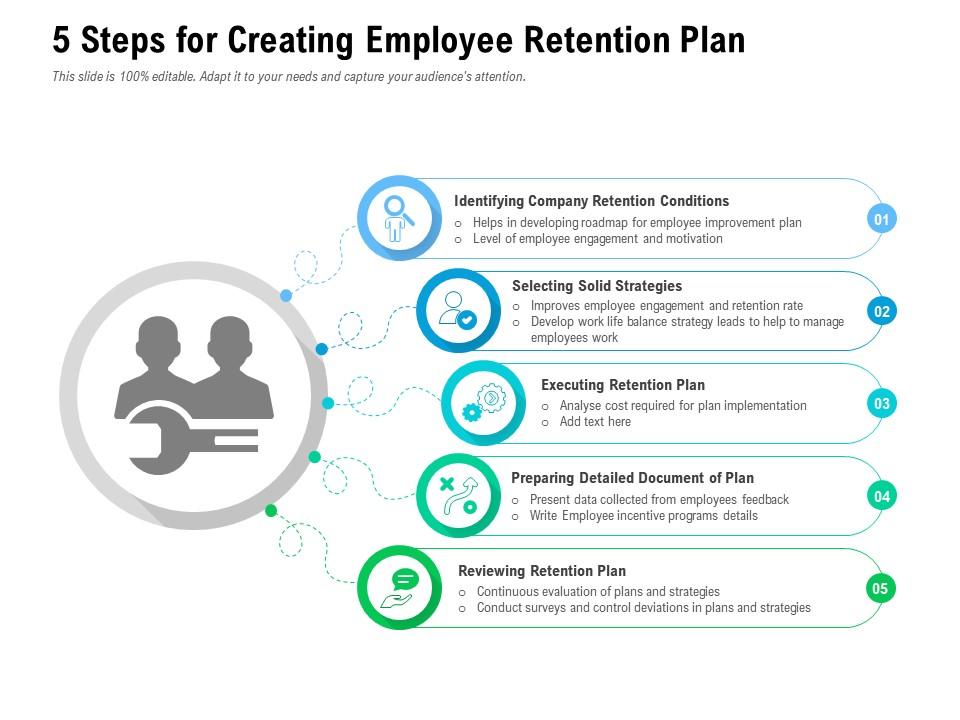Employee retention is a critical issue for businesses of all sizes. When employees leave, the company loses valuable knowledge and experience. In addition, the cost of recruiting and training a new employee can be significant. That’s why it’s important to have an employee retention plan in place. In this blog post, we will discuss employee retention plans for small and large businesses. We will also discuss how to choose an employee retention program that meets your needs.
Understanding Employee Retention In Brief

An employee retention plan is a strategy for keeping employees engaged and committed to your organization. As part of a plan, it includes practices and programs designed to improve job satisfaction, reduce turnover, and encourage employees to stay productively with the company.
Incidentally, employee retention has numerous benefits for businesses. By reducing turnover, businesses can save money on recruiting and training costs. In addition, retaining experienced employees can improve morale and job satisfaction, thereby increasing customer satisfaction and business outcomes.
It is worthy to note that, employee engagement is a key driver of employee retention. Employees who are engaged with their work are more likely to be satisfied with their jobs and less likely to leave the company.
Types of Employee Retention Models

There are two main types of employee retention models: active and passive.
- Active employee retention models focus on proactive measures to keep employees engaged and motivated.
- Passive employee retention models focus on reactive measures to address the causes of employee turnover.
Which Model Is Better
There is no one-size-fits-all answer to this question. The type of employee retention plan that is right for your business depends on the needs of your organization. However, most experts agree that a combination of both active and passive retention strategies is often the most effective approach.
The Integral Role of HR in Employee Retention

Human resources play a vital role in employee retention. HR is responsible for recruiting, hiring, and onboarding new employees. In addition, HR is responsible for creating and implementing policies that promote a positive work environment.
Furthermore, HR is often the first point of contact for employees with questions or concerns. Therefore, HR needs to be knowledgeable about the organizational values/ beliefs/ operations and be able to answer any questions that employees may have.
More important than anything, the HR professional should be neutral and objective when addressing employee concerns. They should also be able to resolve conflict fairly and impartially.
Knowing Reasons Why Employees Quit
There are many reasons why employees quit their jobs. As an employer, it’s important to be aware of these factors so you can address them in your employee retention plan.
Top Reasons Behind High Employee Turnover
The top reasons behind high employee turnover are:
- Lack of opportunity for advancement: When employees feel like they’re stuck in a dead-end job, they’re more likely to look for new opportunities elsewhere.
- Poor working conditions: If your workplace is unsafe, uncomfortable, or otherwise unpleasant, employees will be less likely to stay.
- Lack of appreciation: Employees who don’t feel appreciated are more likely to look for a new job.
- Low pay: If your employees are underpaid, they’ll be more likely to leave for a better-paying job.
Six Stages To Success With Employee Lifecycle Management

The employee lifecycle has six stages: attraction, engagement, development, retention, separation, and rehire. To build a strong workforce and reduce turnover, you need to focus on each stage of the employee lifecycle.
Attraction
The first stage of the employee lifecycle is attraction. This is when you identify the talent you need and find the right candidates to fill those roles.
Engagement
The second stage of the employee lifecycle is engagement. This is when you onboard new employees and help them acclimate to their new roles. You should also introduce them to your company culture and values so they can start to feel like part of the team.
Development
The third stage of the employee lifecycle is development. This is when you invest in your employees and help them grow their skills. You can do this through training programs, mentorship, or by giving them opportunities to take on new projects.
Retention
The fourth stage of the employee lifecycle is retention. This is when you work to keep your employees happy and engaged in their work. You can do this by offering competitive compensation, benefits, and perks. You should also create a positive work environment where employees feel supported and valued.
Separation
The fifth stage of the employee lifecycle is separation. This is when an employee leaves your company, either voluntarily or involuntarily. When an employee leaves, it’s important to conduct an exit interview to understand why they’re leaving and what you can do to prevent other employees from leaving in the future.
Rehire
The sixth stage of the employee lifecycle is rehiring. This is when you identify the need to fill a role that has been vacated and find the right candidate to fill it. When you rehire an employee, it’s important to consider why they left in the first place and what you can do to prevent them from leaving again.
NOTE: By focusing on each stage of the employee lifecycle, you can build a strong workforce and reduce turnover.
Devising an Employee Retention Plan

You can’t just attract top talent and then hope they stick around. You need to engage them from the start and continue to develop them throughout their time with your company. Also, you need to have a plan for when they do leave, so you can rehire the best employees and keep your business running smoothly.
Six Components In Employee Retention Plan

The six components of an employee retention plan are:
- Tailoring the plan to your company’s needs: The plan should be specific to your company and its culture. It should take into account the size of your company, the industry you’re in, and the turnover rate.
- Addressing the causes of employee turnover: There are many reasons why employees leave their jobs. Thus, the first step in addressing these issues is to identify the causes of employee turnover. Once you know the reasons, you can develop strategies to address them.
- Implementing proactive measures to keep employees engaged: Proactive measures are designed to keep employees engaged and motivated. These can include offering training and development opportunities, providing competitive salaries and benefits, and creating a positive work environment.
- Implementing reactive measures to address the causes of employee turnover: Reactive measures are designed to address the causes of employee turnover. These can include increasing pay, improving working conditions, and providing more opportunities for advancement.
- Evaluating the effectiveness of the plan: It’s important to evaluate the effectiveness of your employee retention plan regularly. This will help you identify areas that need improvement and make adjustments as necessary.
- Adjusting the plan as needed: As your company grows and changes, so too will the needs of your employees. As such, it’s important to adjust your employee retention plan as needed.
Employee Retention Strategies For Small Businesses

Small businesses often have a hard time retaining employees. This is because they typically don’t have the same resources as larger businesses. Thus, it can be difficult to implement a comprehensive retention plan. As a result, they need to be more creative in their approach to employee retention.
Some ideas for small businesses include:
- Communicating regularly with your employees: This will help you stay informed about their concerns and needs. Also, be sure to provide feedback on their performance.
- Offering flexible work hours: One way to make your small business more attractive to employees is by offering flexible work hours. This will allow employees to have a better work-life balance, which can lead to increased job satisfaction and commitment.
- Creating a positive work environment: Another key factor in employee retention is the work environment. Employees want to work in an environment that is positive and supportive. If your workplace is negative or stressful, employees will be more likely to leave.
- Implementing an employee referral program: Another way to improve employee retention in small businesses is by implementing an employee referral program. This program incentivizes employees to refer qualified candidates to your company. In addition, it helps to build a positive reputation for your company, which can attract new talent.
- Showing appreciation for employees’ contributions: Finally, it’s important to show appreciation for your employee’s contributions. When employees feel valued and appreciated, they are more likely to be loyal to your company.
Employee Retention Strategies For Large Businesses

Large businesses face different challenges when it comes to employee retention. With a larger workforce, there are more turnover opportunities. In addition, large businesses may have more difficulty creating a positive work environment and providing opportunities for employee growth.
However, large businesses have many resources at their disposal, which makes it easier to implement a comprehensive employee retention plan. Noteworthily, with a large workforce, it’s also important to tailor the plan to the specific needs of your company.
Some tips for large businesses include:
- Offering competitive salaries and benefits: One of the most important factors in employee retention is compensation. To retain your best employees, you need to offer competitive salaries and benefits.
- Conducting regular stay interviews: A stay interview is a meeting between an employer and employee to discuss the employee’s satisfaction with their job. Stay interviews can help identify potential problems before they lead to employee turnover.
- Offering mentorship programs: Mentorship programs pair experienced employees with newer employees to provide guidance and support. These programs can help new employees adjust to the workplace and feel more engaged in their jobs.
- Implementing an employee recognition program: An employee recognition program is a great way to show appreciation for your employees’ hard work. Recognizing employees for their accomplishments can help improve morale and job satisfaction.
- Providing opportunities for career development: Large businesses can offer a variety of career development opportunities, such as job shadowing, cross-training, and tuition reimbursement. These opportunities can help employees gain new skills and knowledge, and feel more invested in their careers.
A Word From MantraCare Wellness
Employee wellness programs are the key to improving employee motivation, productivity, and retention. At MantraCare Wellness, we have a team of health experts, counselors, and coaches who serve corporate employees with 10+ wellbeing programs including EAP, Employee Diabetes Reversal, Corporate MSK, PCOS, Employee Fitness, Corporate Yoga, Employee meditation, and Employee Smoking Cessation.


